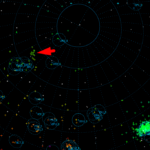Mariasole Maglione (GAV, Gruppo Astrofili Vicentini)
Lorenzo Barbieri (CARMELO network and AAB, Associazione Astrofili Bolognesi)
Introduction
October is the month of the Orionids (ORI). The CARMELO network recorded a moderate increase in meteor activity between October 21 and 22, and a further increase between October 26 and 27.
Methods
The CARMELO network consists of SDR radio receivers. In them, a microprocessor (Raspberry) performs three functions simultaneously:
- By driving a dongle, it tunes the frequency on which the transmitter transmits and tunes like a radio, samples the radio signal and through the FFT (Fast Fourier Transform) measures frequency and received power.
- By analyzing the received data for each packet, it detects meteoric echoes and discards false positives and interference.
- It compiles a file containing the event log and sends it to a server.
The data are all generated by the same standard, and are therefore homogeneous and comparable. A single receiver can be assembled with a few devices whose total current cost is about 210 euros.
To participate in the network read the instructions on this page.
October data
In the plots that follow, all available at this page, the abscissae represent time, which is expressed in UT (Universal Time) or in solar longitude (Solar Long), and the ordinates represent the hourly rate, calculated as the total number of events recorded by the network in an hour divided by the number of operating receivers.
In fig.1, the trend of signals detected by the receivers for the month of October.

Fig. 1: October 2025 data trend.
Orionids
The Orionids (ORI) are an annual meteor shower originating from Comet 1P/Halley. Every year, the Earth encounters the stream of particles left by the comet along its orbit, giving rise to the shower, which is active between early October and the first days of November. The peak of activity is usually around October 22, with a ZHR that can reach about 25 meteors per hour under favorable conditions. These meteors are quite fast: they enter the Earth’s atmosphere at about 67.5 km/s, producing rapid and thin trails, sometimes with particularly bright meteors.
The Orionids have also shown episodes of sudden increases in activity (outbursts) in the past. In particular, in 1993, an unexpected outburst was recorded on the nights between October 16 and 18, a few days before the expected peak. During those nights, very bright meteors were also observed at solar longitudes around 202°–205°. The phenomenon did not repeat itself the following year (1).
The radiant of the Orionids is located in the constellation Orion, near the star Betelgeuse. This means that the meteors appear to come from this area of the sky. For observers in the northern hemisphere, such as the CARMELO network, the radiant rises late in the evening and reaches its maximum elevation in the hours just before dawn. In fig.2, the hourly rate of signals received on days when an increase in the number of meteors was recorded, consistent with Orionid activity, is overlaid with a blue line indicating the elevation of the radiant.

Fig. 2: Hourly rate of events recorded between October 17 and 29, based on solar longitude.
This year, the CARMELO network detected a noticeable increase in the hourly rate of events detected between solar longitudes 208° and 209°, i.e., between October 21 and 22. However, just as the Earth was expected to pass through the peak of the Orionid meteor shower on October 22, the Graves radar was turned off for about 4 hours.
We also noticed a further increase between solar longitudes 212° and 214°, i.e. between October 26 and 27 (see fig. 2).
The CARMELO network
The network currently consists of 14 receivers, 12 of which are operational, located in Italy, the UK, Croatia and the USA. The European receivers are tuned to the Graves radar station frequency in France, which is 143.050 MHz. Participating in the network are:
- Lorenzo Barbieri, Budrio (BO) ITA
- Associazione Astrofili Bolognesi, Bologna ITA
- Associazione Astrofili Bolognesi, Medelana (BO) ITA
- Paolo Fontana, Castenaso (BO) ITA
- Paolo Fontana, Belluno (BL) ITA
- Associazione Astrofili Pisani, Orciatico (PI) ITA
- Gruppo Astrofili Persicetani, San Giovanni in Persiceto (BO) ITA
- Roberto Nesci, Foligno (PG) ITA
- MarSEC, Marana di Crespadoro (VI) ITA
- Gruppo Astrofili Vicentini, Arcugnano (VI) ITA
- Associazione Ravennate Astrofili Rheyta, Ravenna (RA) ITA
- Mike German a Hayfield, Derbyshire UK
- Mike Otte, Pearl City, Illinois USA
The authors’ hope is that the network can expand both quantitatively and geographically, thus allowing the production of better quality data.
References
(1) P. Jenniskens (2006): “Meteor showers and their parent comets”. Cambridge University Press, p. 301-302





